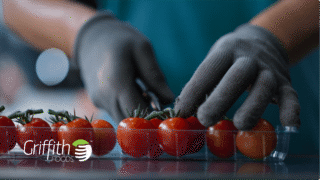Challenge
As physical expansion of facilities was not an option, Griffith Foods had to look for other ways to produce more. A pain point was the production line downtime during cleanings. To assure the quality of each product and avoid cross-contamination, such as mixing dyes or allergens, the production line must be completely cleaned between various product types.
This process is known as wet cleaning. It takes 30 to 90 minutes, often bringing production lines to a standstill. Downtime means lost sales, so the need was high to reduce this cleaning time. On the positive side, extensive wet cleaning is not always necessary. If product types are compatible, a quick ‘dry cleaning’ is enough, where the machines are hosed down with high air pressure.
Services used
AI Expertise
Data Science & Machine Learning
Solution
To reduce cleaning time, our specialists wrote an artificial intelligence algorithm based on Griffith Foods’ product data. The algorithm uses this data to determine an optimal product sequence based on product similarities and differences and forms sequences of products that only need dry cleaning. This greatly reduces the number of longer wet cleanings, which only need to be done between incompatible sequences.

Implementation
To make sure that Griffith Foods did not invest in an artificial intelligence model that would not deliver the best results, we first manually collected and analysed data on key features that influence the planning process, assisted by Griffith Foods’ own planning experts. After identifying these critical factors, our AI experts selected potential models and did several rounds of testing and fine-tuning. This manual method helped us narrow down to two models that performed well. These models could be further trained for even better results and in the end, we chose the best-performing model for implementation.
The operators at Griffith Foods played a crucial role in this implementation process by sharing their specific knowledge. They have years of experience in flagging the parameters that affect planning, so their expertise was invaluable in refining the models. Additionally, the evaluation of “which model performs best” was conducted with them, ensuring that any model that had a noticeable error rate was assessed for its impact in real scenarios.

Ultimately, the model was tested in practice against manual planning by the operators, who could still intervene in real time if any issues arose in the supply chain. This approach not only maximises the support we provide to the operators and planners but also acknowledges their years of valuable experience.
Griffith Foods also played an instrumental role in ensuring the success of this project beyond its initial implementation. Their leadership team actively collaborated with us to develop an internal communication strategy that highlighted the benefits and successes of the chosen solution. Recognising the success achieved in their Belgian facility, the leadership team at Griffith Foods is now exploring opportunities to replicate and adapt this model in their production sites in other countries.

Results
Less downtime due to wet cleanings immediately resulted in a gain of 17 production days. 5% fewer wet cleanings are now needed thanks to the optimisations of the Hyperion experts.
The return on investment for Griffith Foods is clear:
- Those 17 production days per year that the machines can run extra, reveal a payback period of only 10 months.
- To add to that, the project also had a positive impact on sustainability within Griffith Foods. Fewer wet cleanings meaning a water saving of 1000m² per year and less use of cleaning agents.
Our services
Expert support when you need it most
Your business deserves more than just quick fixes; it needs a partner who understands your goals and challenges. With access to a network of over 500 experts, we’re equipped to provide the right support.
Reliable managed IT services for business growth
Running a business is challenging enough without having to worry about technology. With our tailored managed services, we keep your systems secure, up-to-date, and running smoothly.
Want to take the step together?
Reach out to us, and let’s explore how we can build future-proof solutions together. We’re just a message away!



